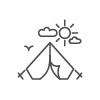Find the perfect tent shape!
First, you should pick the tent shape that suits you best.
Dome tents are all-rounders that are particularly suitable for use on snow, rock or sand, as they are self-supporting due to intersecting pole arches. Only the apsis needs to be tensioned. However, it requires quite a bit of strength and skill to pitch a dome tent when it storms.
Vis-a-vis tents are the perfect companions for family camping holidays. They are similar to tunnel tents, but the sleeping cabins are divided differently. They are not next to each other, but opposite. This means that the living area is located between the two sleeping cabins.
Tunnel tents are particularly suitable for trekking and cycling trips. You can optimally use the space since the side walls are steep. Additionally, they can be set up relatively easily even when it storms and are very storm-proof. However, tunnel tents are not self-supporting and therefore have to be tensioned well.
Trekking tents are the perfect companions for hiking trips. They are especially light and compact and can also usually be set up and disassembled quickly and easily.
Roof tents – a place to sleep under an open starry sky. On the road on the roof of the car and without hotel accommodation. The roof tents can be mounted on almost any vehicle and offer enough space for young and old.
Family tents offer plenty of space for the whole family. They are often not shaped like classic tunnel or dome tents but rather consist of a single room. There, you have several sleeping spaces as well as storage space for your camping equipment.


Roof tents


Useful things to know about camping tents
What is a hydrostatic head?
The hydrostatic head tells you how waterproof a tent is. The value is given in millimetres and measures how much water pressure the tent fabric can withstand. If you use your tent mainly in the summer, a hydrostatic head of at least 2000 mm is recommended. If you also want to go camping during the rest of the year, you should opt for a tent with a hydrostatic head of at least 3000 mm.
And when travelling to rainy areas, such as Norway, we recommend a tent with a hydrostatic head of at least 4000 mm.
What is the BlackOut Bedroom™ technology?
This Coleman technology blocks up to 99 % of daylight. It prevents light from entering your sleeping area so that you can enjoy a restful night’s sleep at any time of day.
What is an apsis?
An apsis provides additional storage space for luggage. It is, for example, a recess in which you can store your shoes or backpacks. The apsis is usually not located in the actual inner tent, but rather attached to the tent.


Accessories for your camping tent



















